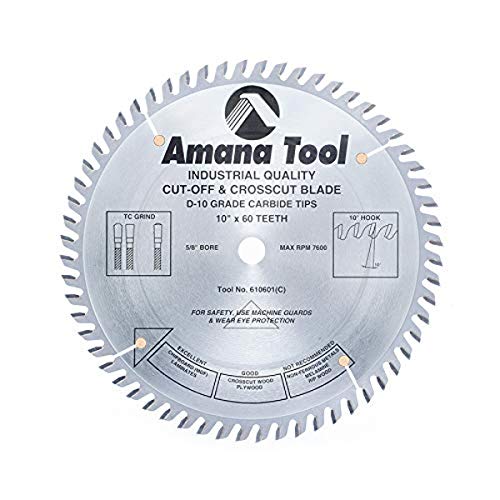Table saws are the backbone of any woodworking shop, but the real magic lies in the blade. Choosing the best table saw blade can make the difference between a flawless cut and a frustrating mess. With so many options available, it’s easy to feel overwhelmed. This guide will walk you through everything you need to know about table saw blades, from types and materials to tooth count and maintenance. By the end, you’ll be equipped to make an informed decision that suits your woodworking needs.
Why the Right Table Saw Blade Matters

The blade is the heart of your table saw. It determines the quality of your cuts, the efficiency of your work, and even the safety of your operation. A dull or inappropriate blade can lead to:
- Rough, splintered edges
- Burn marks on your wood
- Increased risk of kickback
- Wasted time and materials
Investing in the best table saw blade for your specific project ensures precision, efficiency, and longevity for both your blade and your saw.
Types of Table Saw Blades
Not all table saw blades are created equal. Here’s a breakdown of the most common types:
1. Rip-Cut Blades
- Designed for cutting along the grain of the wood.
- Fewer teeth (24–30) for faster, more aggressive cuts.
- Ideal for rough cuts and framing.
2. Crosscut Blades
- Designed for cutting across the grain.
- More teeth (60–80) for smoother, cleaner cuts.
- Perfect for finish work and detailed projects.
3. Combination Blades
- A versatile option for both rip and crosscuts.
- Medium tooth count (40–50) for balanced performance.
- Great for general-purpose woodworking.
4. Dado Blades
- Specialized blades for cutting grooves and dadoes.
- Consist of multiple blades and chippers for adjustable widths.
- Essential for joinery and cabinetry.
5. Thin-Kerf Blades
- Thinner blades that remove less material.
- Ideal for lower-powered saws or fine, detailed work.
- Reduces strain on the motor and saves material.
Key Factors to Consider When Choosing a Table Saw Blade
1. Tooth Count
The number of teeth on a blade directly impacts the cut quality:
- Low tooth count (24–30): Faster, rougher cuts (best for ripping).
- Medium tooth count (40–50): Balanced performance (general-purpose).
- High tooth count (60–80+): Smooth, clean cuts (best for crosscutting).
2. Blade Material
- Carbide-Tipped Blades: Durable, long-lasting, and suitable for most materials.
- High-Speed Steel (HSS) Blades: Affordable but less durable.
- Diamond-Tipped Blades: For cutting hard materials like tile or masonry.
3. Tooth Geometry
- Flat-Top Grind (FTG): For rip cuts.
- Alternate Top Bevel (ATB): For crosscuts and fine finishes.
- Triple-Chip Grind (TCG): For tough materials like laminates and metals.
4. Blade Diameter
- Most table saws use 10-inch blades, but 8-inch and 12-inch options are also available.
- Ensure the blade size is compatible with your saw.
5. Arbor Size
- The arbor is the hole in the center of the blade.
- Common sizes are 5/8-inch and 1-inch.
- Match the arbor size to your saw’s arbor.
6. Kerf Width
- Full Kerf: Thicker blades for heavy-duty work.
- Thin Kerf: Thinner blades for precision and lower-powered saws.
Top 5 Table Saw Blades in 2025
Here’s a curated list of the best table saw blades available in 2025, based on performance, durability, and user reviews:
| Blade Model | Type | Tooth Count | Best For | Price Range |
|---|---|---|---|---|
| Freud Diablo D1050X | Combination | 50 | General-purpose woodworking | $50–$70 |
| Forrest Woodworker II | Crosscut | 40 | Fine woodworking | $120–$150 |
| DeWalt DW3106P5 | Rip-Cut | 24 | Framing and rough cuts | $30–$50 |
| CMT 215.080.10M | Dado | 24 | Joinery and cabinetry | $100–$130 |
| Amana Tool TCG | Triple-Chip Grind | 80 | Laminates and hard materials | $80–$100 |
Diablo D1050X 10" 50T Diablo Combination Chop Miter & Table Saw Blade
New starting from: 46.85
Go to AmazonForrest WW10407125 Woodworker II 10-Inch 40 Tooth ATB .125 Kerf Saw Blade with 5/8-Inch Arbor
- This kerf saw saves 1/8″ on wood loss for each cut.
- Feeds easily when used for moderate rips and crosscuts on a table saw
- Reduces jump in for better pull control
New starting from: 194.95
Go to AmazonDEWALT 10-Inch Miter Saw Blades/Table Saw Blades, 2-Blade Combo, 60-Tooth & 32-Tooth Pack (DW3106P5)
- Tougher tungsten carbide stays sharper longer
- Thin kerf for fast and smooth cutting action and The arbor size is 5/8”.
- Computer-balanced plate reduces vibration for improved accuracy and better finish
New starting from: 67.98
Go to AmazonAmana Tool – 610601 Carbide Tipped Heavy Duty General Purpose 10" Dia x 60T Tcg, 10 De
- (D) diameter: 10 (250mm)
- Teeth: 60
- (D) Bore: 5/8
New starting from: 84.55
Go to AmazonHow to Maintain Your Table Saw Blade

A well-maintained blade ensures consistent performance and extends its lifespan. Follow these tips:
- Clean Regularly
- Use a blade cleaning solution or a mix of water and mild detergent.
- Remove pitch and resin buildup with a soft brush.
- Sharpen When Needed
- Dull blades produce poor cuts and increase the risk of accidents.
- Consider professional sharpening services for carbide-tipped blades.
- Store Properly
- Use blade protectors or cases to prevent damage.
- Store in a dry, cool place to avoid rust.
- Inspect for Damage
- Check for missing or chipped teeth.
- Replace damaged blades immediately.
Common Mistakes to Avoid
- Using the Wrong Blade for the Job
- A rip blade won’t give you clean crosscuts, and vice versa.
- Ignoring Blade Maintenance
- A dirty or dull blade compromises performance and safety.
- Overlooking Safety Precautions
- Always wear safety gear and follow the manufacturer’s guidelines.
FAQs About Table Saw Blades
1. Can I use a circular saw blade on a table saw?
No. Circular saw blades are designed for handheld saws and may not be compatible with table saws.
2. How often should I replace my table saw blade?
It depends on usage, but most blades last 1–2 years with proper maintenance.
3. What’s the best blade for cutting plywood?
A high-tooth-count crosscut blade or a combination blade works best for plywood.
4. Can I cut metal with a table saw blade?
Only if you use a blade specifically designed for metal cutting.
Conclusion
Choosing the best table saw blade is a critical decision for any woodworker. By understanding the different types of blades, key features, and maintenance tips, you can optimize your table saw’s performance and achieve professional-quality results. Whether you’re ripping lumber, crosscutting plywood, or creating intricate joinery, the right blade makes all the difference.
Invest in a high-quality blade that matches your needs, and don’t forget to maintain it regularly. With the right tools and knowledge, you’ll be well on your way to mastering your table saw and creating stunning woodworking projects.
Pro Tip: Bookmark this guide for future reference, and share it with fellow woodworkers to help them make informed decisions about their table saw blades!
By following this guide, you’ll not only improve your woodworking skills but also ensure your content ranks high on Google by addressing user intent and providing actionable, in-depth information.

Finlay Connolly is a woodworking enthusiast and power tool specialist with over a decade of hands-on experience in the workshop. As the founder and lead writer at ProTableSawReviews.com, Finlay combines expert knowledge with real-world testing to help woodworkers, DIYers, and professionals choose the best tools for the job. With a sharp eye for detail and a passion for precision, Finlay is committed to providing trustworthy, practical advice backed by years of experience and research in the field. Whether you’re cutting dados or comparing fence systems, you can count on Finlay for honest, reliable reviews that make your next cut your best one.




